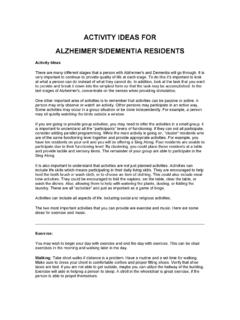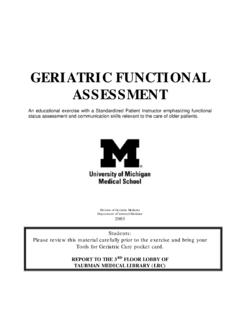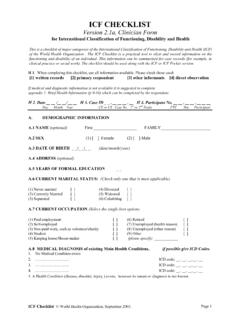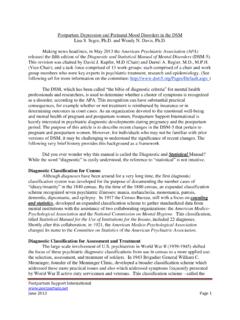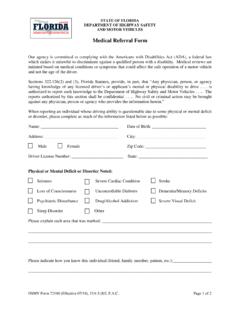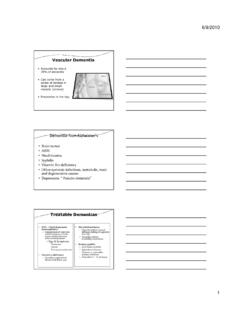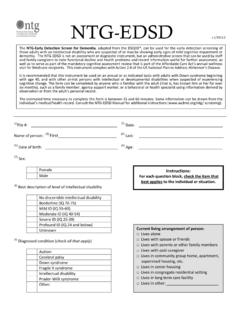Transcription of LEWY BODY DEMENTIA - National Institutes of Health
1 LEWY body DEMENTIAI nformation for Patients, Families, and ProfessionalsLEARN ABOUT: DEMENTIA with Lewy bodies Parkinson s disease dementiaNational Institute on AgingNational Institute of Neurological Disorders and StrokeCONTENTSI ntroduction ..1 The Basics of Lewy body DEMENTIA ..2 Diagnoses of Lewy body DEMENTIA ..5 Causes and Risk Factors ..7 Common Symptoms ..8 Diagnosis ..13 Treatment and Management ..17 Advice for People Living with Lewy body DEMENTIA ..27 Caring for a Person with Lewy body DEMENTIA ..30 Research The Road Ahead ..36 Resources ..371 IntroductionLewy body DEMENTIA (LBD) is a complex and challenging brain disorder. It is complex because it affects many parts of the brain in ways that scientists are trying to understand more fully. It is challenging because its many possible symptoms make it hard to do everyday tasks that once came easily. Although less known than its cousins Alzheimer s disease and Parkinson s disease, LBD is not a rare disorder.
2 More than 1 million Americans, most of them older adults, are affected by its disabling changes in the ability to think and researchers seek better ways to treat LBD and ultimately to find a cure people with LBD and their families struggle to get an accurate diagnosis, find the best treatment, and manage at home. This booklet is meant to help people with LBD, their families, and profes-sionals learn more about the disease and resources for coping. It explains what is known about the different types of LBD and how they are diagnosed. Most importantly, it describes how to treat and manage this difficult disease, with practical advice for both people with LBD and their caregivers. A list of resources begins on page 37. 2 The Basics of Lewy body DementiaLBD is a disease associated with abnormal deposits of a protein called alpha-synuclein in the brain. These deposits, called Lewy bodies, affect chemicals in the brain whose changes, in turn, can lead to problems with thinking, movement, behavior, and mood.
3 LBD is one of the most common causes of is a severe loss of thinking abilities that interferes with a person s ability to perform daily activities such as household tasks, personal care, and handling finances. DEMENTIA has many possible causes, including stroke, brain tumor, depression, and vitamin deficiency, as well as disorders such as LBD, Alzheimer s, frontotemporal DEMENTIA , and vascular DEMENTIA . Diagnosing LBD can be challenging. Early LBD symptoms are often confused with similar symptoms found in other brain diseases like Alzheimer s or in psychiatric disorders like schizophrenia. Also, LBD can occur alone or along with other brain are two LBD diagnoses DEMENTIA with Lewy bodies and Parkinson s disease DEMENTIA . The earliest signs differ but reflect the same biological changes in the brain. Over time, people with DEMENTIA with Lewy bodies or Parkinson s disease DEMENTIA may develop similar Is Affected by LBD?
4 LBD affects more than 1 million individuals in the United States. LBD typically begins at age 50 or older, although sometimes younger people have it. LBD appears to affect slightly more men than is a progressive disease, meaning symptoms start slowly and worsen over time. The disease lasts an average of 5 to 8 years from the time of diagnosis to death, but the time span can range from 2 to 20 years. How quickly symptoms develop and change varies greatly from person to person, depending on overall Health , age, and severity of symptoms. 3In the early stages of LBD, symptoms can be mild, and people can function fairly normally. As the disease advances, people with LBD require more help due to a decline in thinking and movement abilities. In the later stages of the disease, they often depend entirely on others for assistance and LBD symptoms may respond to treatment for a period of time.
5 Currently, there is no cure for the disease. Research is improving our understanding of this challenging condition, and advances in science may one day lead to better diagnosis, improved care, and new TermsThe terms used to describe Lewy body DEMENTIA (LBD) can be confusing. Doctors and researchers may use different terms to describe the same condition. In this booklet, the term Lewy body DEMENTIA is used to describe all dementias whose primary cause is Lewy bodies in the brain. LBD may be diagnosed as: DEMENTIA with Lewy bodies, in which cognitive (thinking) symptoms appear within a year of movement problems Parkinson s disease DEMENTIA , in which cognitive symptoms develop more than a year after the onset of movement problemsAs LBD progresses, symptoms of both types of LBD are very Are Lewy Bodies?Lewy bodies are named for Dr. Friederich Lewy, a German neurologist. In 1912, he discovered abnormal protein deposits that disrupt the brain s normal functioning in people with Parkinson s disease.
6 These abnormal deposits are now called Lewy bodies. Lewy bodies are made of a protein called alpha-synuclein. In the healthy brain, alpha-synuclein plays a number of important roles in neurons (nerve cells) in the brain, especially at synapses, where brain cells communicate with each other. In LBD, alpha-synuclein forms into clumps inside neurons, starting in areas of the brain that control aspects of memory and movement. This process causes neurons to work less effectively and, eventually, to die. The activities of certain brain chemicals are also affected. The result is widespread damage to specific brain regions and a decline in abilities affected by those brain bodies affect several different brain regions in LBD: the cerebral cortex, which controls many functions, including information processing, perception, thought, and language the limbic cortex, which plays a major role in emotions and behavior the hippocampus, which is essential to forming new memories the midbrain and basal ganglia, which are involved in movement the brain stem, which is important in regulating sleep and maintaining alertness brain regions important in recognizing smells (olfactory pathways)Microscopic image of a Lewy of Carol F.
7 Lippa, MD, Drexel University College of of Lewy body DementiaLewy body DEMENTIA refers to either of two related diagnoses DEMENTIA with Lewy bodies and Parkinson s disease DEMENTIA . Both diagnoses have the same underlying changes in the brain and, over time, people with either diagnosis develop similar symptoms. The difference lies largely in the timing of cognitive (thinking) and movement symptoms. In DEMENTIA with Lewy bodies, cognitive symptoms develop within a year of parkinsonism any condition that involves the types of movement changes, such as tremor or muscle stiffness, seen in Parkinson s disease. In Parkinson s disease DEMENTIA , cognitive symptoms develop more than a year after the onset of movement problems. Not-so-sweet dreamsIn his mid-60s, Bruce started having mild confusion and vivid dreams in which he thrashed around and even fell out of bed . His neurologist diagnosed REM sleep behavior disorder and mild cognitive changes.
8 Two years later, Bruce s confusion had progressed to DEMENTIA , and he had slowness of movement . His neurologist referred him for neuropsychological testing and, based on the results, changed his diagnosis to DEMENTIA with Lewy bodies . DEMENTIA with Lewy Bodies People with DEMENTIA with Lewy bodies have a decline in thinking ability that may look somewhat like Alzheimer s disease. But over time they also develop movement and other distinctive symptoms that suggest DEMENTIA with Lewy bodies. Symptoms that distinguish this form of DEMENTIA from others may include: visual hallucinations early in the course of DEMENTIA fluctuations in cognitive ability, attention, and alertness slowness of movement, tremor, difficulty walking, or rigidity (parkinsonism)6 REM sleep behavior disorder, in which people physically act out their dreams by yelling, flailing, punching bed partners, and falling out of bed more trouble with mental activities such as multitasking and problem solving than with memory early in the course of the diseaseParkinson s Disease DementiaParkinson s disease DEMENTIA starts as a movement disorder, with symptoms such as slowed movement, muscle stiffness, tremor, and a shuffling walk.
9 These symptoms are consistent with a diagnosis of Parkinson s disease. Later on, cognitive symptoms of DEMENTIA and changes in mood and behavior may all people with Parkinson s disease develop DEMENTIA , and it is difficult to predict who will. Many older people with Parkinson s develop some degree of DEMENTIA . Parkinson s progressesBetty is retired from the high school food-services department and is devoted to her family, especially her three granddaughters . At age 73, Betty developed a mild tremor in one hand, cramped hand- writing, a shuffling gait, and a stooped posture . She was diagnosed with Parkinson s disease . When she started having hallucinations 3 years later, her children became alarmed . Betty soon started having problems with confusion and visual-spatial orientation . She was diagnosed with Parkinson s disease DEMENTIA .7 Causes and Risk FactorsThe precise cause of LBD is unknown, but scientists are learning more about its biology and genetics.
10 For example, we know that an accumulation of Lewy bodies is associated with a loss of certain neurons in the brain that produce two important neurotransmitters, chemicals that act as messengers between brain cells. One of these messengers, acetylcholine, is important for memory and learning. The other, dopamine, plays an important role in behavior, cognition, movement, motivation, sleep , and mood. Scientists are also learning about risk factors for LBD. Age is considered the greatest risk factor. Most people who develop the disorder are over age known risk factors for LBD include the following: Diseases and Health conditions Certain diseases and healthconditions, particularly Parkinson s disease and REM sleep behaviordisorder, are linked to a higher risk of LBD. Genetics While having a family member with LBD may increasea person s risk, LBD is not normally considered a genetic in three genes APOE, SNCA, and GBA have beenassociated with an increased risk of DEMENTIA with Lewy bodies, butin most cases, the cause is unknown.










